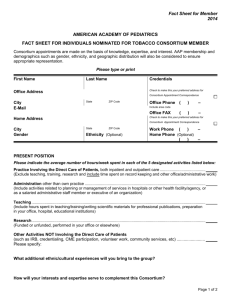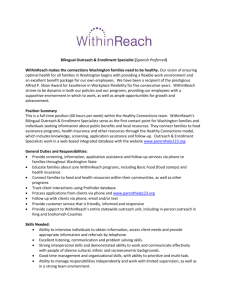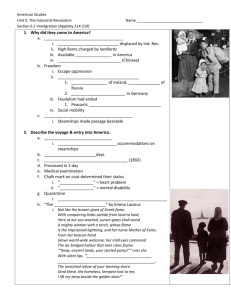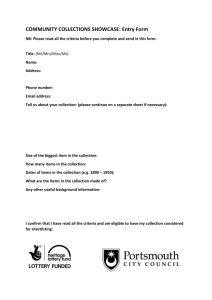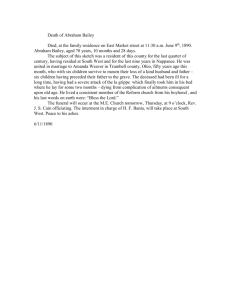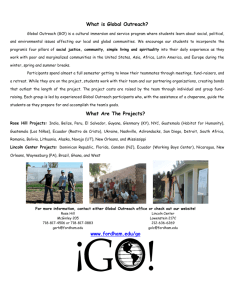Southern Agbiotech Consortium for Underserved Communities
advertisement
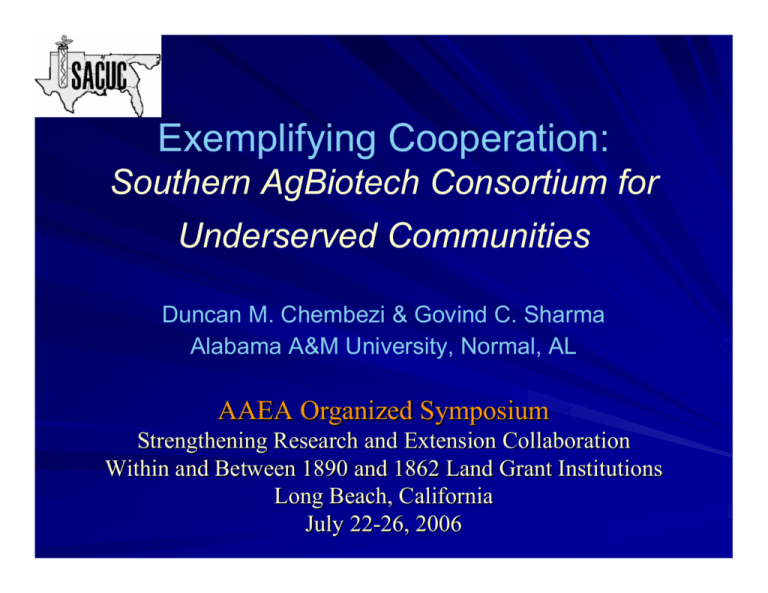
Exemplifying Cooperation: Southern AgBiotech Consortium for Underserved Communities Duncan M. Chembezi & Govind C. Sharma Alabama A&M University, Normal, AL AAEA Organized Symposium Strengthening Research and Extension Collaboration Within and Between 1890 and 1862 Land Grant Institutions Long Beach, California July 22-26, 2006 What is SACUC? The Southern AgBiotech Consortium for Underserved Communities (SACUC) was a jointly and carefully planned effort of eleven 1890 institutions to promote agricultural biotechnology outreach to farmers and consumers and strengthen K-Life science education (2001 through 2005). SACUC Objectives Educational Outreach focused primarily on K-12 activities – Teacher/student training; Commodity Outreach included crop identification, critical analysis, demonstration plot establishment and; Community Outreach was achieved by organized field days coupled with small farmer and professional worker training; Socioeconomic studies assessed the educational effectiveness as well as public perception, acceptance, and adoption of biotechnology by consumers, producers, and students. An 11-University Consortium Alabama A&M University (AAMU) Alcorn State University (ASU) Florida A&M University (FAMU) Fort Valley State University (FVSU) Langston University (LU) North Carolina A&T and State Univ. (NCAT) Prairie View A&M University (PVAMU) Southern University (SU) Tennessee State University (TSU) Tuskegee University (TU) University of Arkansas at Pine Bluff (UAPB) Problem Area Identification Two pre -proposal meetings were held in proposal in 2000 among 1890 faculty 8-10 institutional representatives attended each meeting Basic components of the project were commonly agreed upon Refinement of Problem Area Holding of these meetings was the best investment the institutions had made. – It developed camaraderie and exchange of ideas among the institutions. The main project components: education, training, crop demonstrations, and socioeconomic studies were agreed upon. Project Development One of the best things CSREES did and continues to do was the advance notice. The key thrust areas for RFP were well-known over a 4-month period Jan.-May 2000. Each participating campus in the consortium provided written and budgetary input. Heated philosophical and pragmatic discussions helped. Management/Team Building/ Pre-agreed Principles We had a close working relationship with ARD/1890 administrators We had a decentralized structure One lead institution but…. Four co-lead institutions; one for each of the four objectives Each institution had common minimum work and therefore, base funding Management/Team Building/ Pre-agreed Principles Each Objective had a coordinating committee We had a yearly meeting and an annual report We had a small but a hands-on advisory board and an external evaluator (Auburn University) We identified and worked with key “industry” and other “not-for-profit” cooperators Functioning of SACUC SACUC Advisory Committee – – – – Dr. David Gilchrist, UC Davis, CEPRAP/ Pathologist Dr. Fred Buttle, Rural Sociology, Univ. of Wisconsin Mr. Ralph Page, Federation of Southern Cooperatives Dr. Curtis Jolly, Auburn University (External Evaluation) Administrative Support Team (AST) – Deans and Directors,1890 Administrators & ARD What did we Learn? Size of the consortium? Inter-University consortium culture. “GM crops: European reaction” & other factors causing slowing new crop entry. Other Lessons Learned Stronger links with the State, City and County-level Boards of Education Science Education: AgScience Education Was extension sufficiently integrated in SACUC planning & implementation? Federation’s decision on the SACUC Advisory Committee Positive Lessons Learned Pre-proposal planning meetings (2) integrated ideas from cross-section of teaching, research and extension. We needed to submit a proposal to IFAFS CSREES Initiative for Future Agriculture & Food Systems (IFAFS), under Social Science Component which we did not. Positives at Programmatic Level Underserved focus allowed us to work in counties with the most need. Knowledge and resource transfer to high schools. Scientists/extension personnel conducted on-station and on-farm demonstrations. Positives at Programmatic Level Expanded teaching, research and public outreach efforts in agricultural biotechnology. Each of the11 SACUC institutions received funds for biotech education, research or outreach Improved communications between: 9 Faculty at different campuses. 9 Life scientists and social scientists. 9 Researchers, extension faculty & agents. 9 University and high school faculty. Positives at Programmatic Level SACUC provided resources to undertake regional socioeconomic studies. Stimulated interest in graduate level research on our campuses. Partnered with public, private (Monsanto) and governmental entities. THE END Any questions, comments or suggestions?


